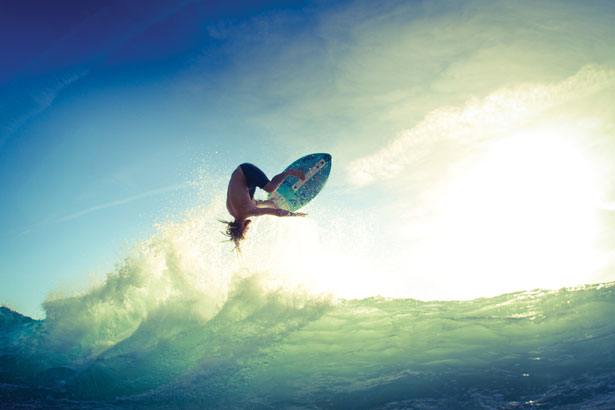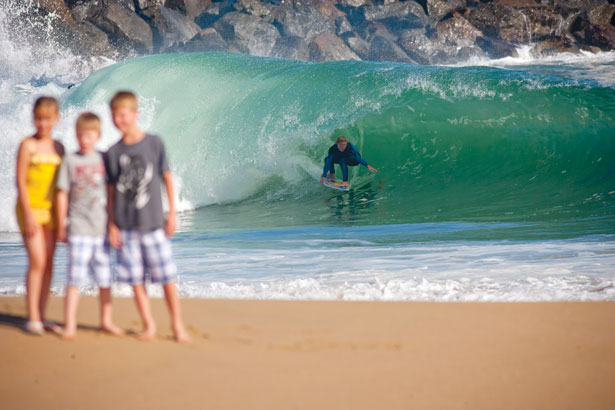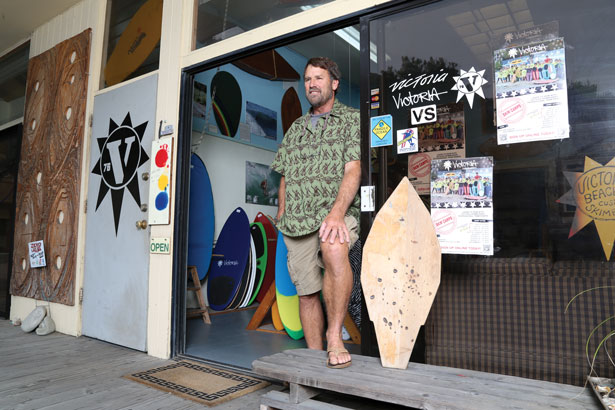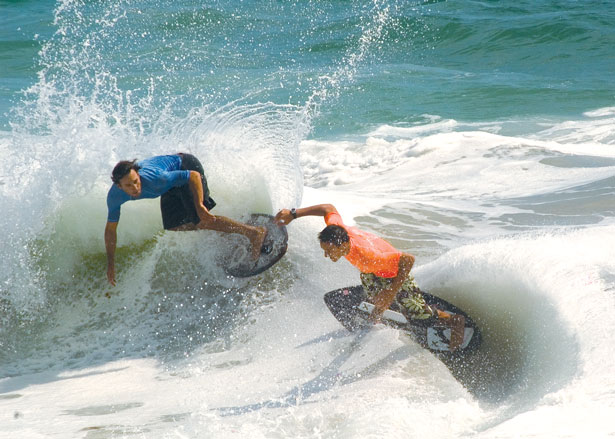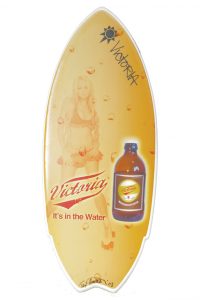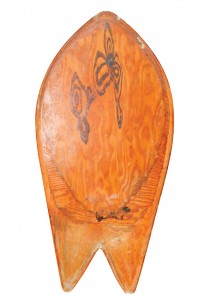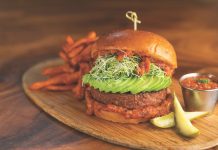In the heart of skimboarding country, locals share their thoughts on the pros and cons of the sport going mainstream. – By Sharael Kolberg
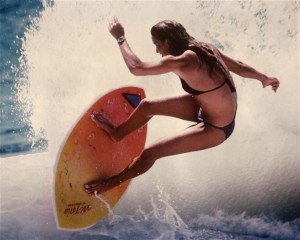 Although skimboarding’s roots may date back to the 1920s when Laguna Beach locals would skim on boards carved out of plywood, the sport has not quite exploded onto the mainstream scene as much as some other water sports, such as surfing. While there is a continual effort made to push the sport in that direction, some skimmers are happy with keeping it small.
Although skimboarding’s roots may date back to the 1920s when Laguna Beach locals would skim on boards carved out of plywood, the sport has not quite exploded onto the mainstream scene as much as some other water sports, such as surfing. While there is a continual effort made to push the sport in that direction, some skimmers are happy with keeping it small.
Sense of Community
For Tex Haines, skimboarding is his life. It’s a sport that he is passionate about and that he has turned into a successful career; the founder of Victoria Skimboards has been skimming in Laguna Beach since he was a kid in the 1960s.
“There’s a ‘familiness’ about skimboarding,” Tex says. “When I was a kid, my parents would rent a house at Victoria Beach, and we’d skim there all summer with all the other kids from the area. I’d rather not have it grow and get too commercial. Smaller is better because then the beaches are less crowded and you can catch more waves.”
Tex hopes the sport keeps its sense of community. Head down to Victoria, Thalia, Aliso or 10th Street on any summer day and you’ll find skimboarders lining the water’s edge not only trying to catch the perfect ride, but also using their down time to shoot the breeze about life as an adolescent. If the sport rockets into the mainstream, skimmers might be spending more time just finagling their way to a vacant spot of ride-able ocean.
Competitive Spirit
Having launched Victoria Skimboards in 1976 with then-partner Peter Prietto, Tex has seen the progression of the sport grow slowly over the years. The company not only manufactures skimboards, but also apparel and accessories, and provides team sponsorship. A milestone for the sport and company was the start of the Vic Skim World Championship of Skimboarding competition in 1977. The winner of that first event was Tommy Trager, who was most likely the first recognized pro skimboarder. Soon after his win, he was featured on the cover of Sports Illustrated magazine, an honor that belongs to an elite group of athletes. However, even with the national recognition, the sport did not become a household name.
The Vic Skim, as it is dubbed, has brought out the best skimboarders in the world and really validated Laguna Beach as a top-notch international skimboarding destination. In 1987 it had enough pro skimboarders to add a pro division to the competition.
Many top-ranking skimboarders are from Laguna Beach, including Bill Bryan, Chris Henderson, Morgan Just and Blair Conklin. Growing up here, most kids have tried it at least once. For some, they are instantly hooked and have a lifetime to fine-tune their skills on the perfect skimboarding terrain at beaches such as Aliso, Thalia, Victoria and 10th Street.
Retired pro skimboarder Chris Henderson, often referred to as the godfather of skimboarding, says, “Laguna is known as the ‘North Shore’ of skimboarding due to the steep incline of the beaches that allows for powerful shore breaks.” He has spent the last 47 years enjoying the perfect skimboarding conditions Laguna has to offer.
Those who are dedicated and driven are inevitably drawn to compete. With competition comes the allure to go pro. For competitive skimboarders, going pro is a dream they continually strive for. However, because of the lack of hefty sponsors, very few actually realize the dream of getting paid to skim for a living.
Bill Bryan has been one of the lucky ones. As a 14-time World Skimboarding Champion, Bill knows what it’s like to be pro and has enjoyed competing. “It’s a really good thing,” he says. “Although, sometimes during a competition the waves are really tight, so it’s really only good for a couple of hours. And at high tides the waves vanish. It’s a time constraint. Pro-only events give more time to catch good waves.” For pros, putting skimboarding in the limelight means more sponsors and a longer, more lucrative career.
Aaron Peluso, co-founder of Exile Skimboards based out of San Clemente, agrees that the sport could stand to grow a bit. His company sponsors team riders and he feels pro skimboarders deserve more recognition. “It would be nice to see skimboarding grow to the size where the pro athletes that dedicate their lives to participating can do so without sacrificing their long-term financial stability and careers and to at least make some reasonable money to parlay that into a career afterwards,” he says. Aaron feels that part of the reason the industry has been held back is because of its perception of being a purely recreational sport. “It’s thought of as a sand-slicing sport and that’s why it hasn’t ignited,” he says. “People think of it as something their 6-year-old cousin does at the beach in the summer. It’s much more technical than that.”
In 2010, the women finally got a chance to strut their skimboarding skill with the addition of the women’s pro division in the Vic Skim World Championship competition. Thanks in part to the driving force, SkimChicks, who pushed for the pro division, the competition was a success and brought notoriety to the sport and took it to a new level. Female skimboarding star Amber Cottle, who was an announcer at the event, says, “Just to legitimize skimboarding as a sport will empower more girls to get involved.”
At age 19, Sam Stinnett is the current reigning world champion of skimboarding. Even at such a young age, Sam has had years of skimming under his belt, having started competing at age 7. By 15, he had gone pro. “Skimming is by hobby, my life. I love it so much,” he says. Sam comes from a family of skimboarders who grew to love the sport when they moved to Aliso Beach. Sam’s dad, Scott Stinnett Sr., says that after getting tired of the politics on the baseball field when his three boys were young, he took them to watch the Victoria Skimboards contest near their house and it immediately sparked an interest. “We pay so much to live in Laguna Beach,” Scott Sr. says. “It’s nice to be involved in a sport that actually gets us out on the beach.”
Sam can often be found with older brothers Jake (24), also a pro rider, and Scott Jr. (25), a documentary filmmaker, by his side at the beach. “It’s so much fun to skim with one brother while the other one documents our epic trips,” Sam says.
Even as world champion, Sam and up-and-coming skimboarders such as Blair Conklin, the youngest pro rider on the circuit at age 16, are unsure about what the future holds for them as pros, but are enjoying the ride.
“Even the top skimboarders have another job,” Sam says. “Some of the best riders can’t even go to all the contests because they can’t miss work.”
Blair, whose talent shines when he’s getting tubed and doing aerials in the ocean, shows what the progression of the sport has become. It’s no longer about sliding along the shoreline. It takes athleticism, technique, dedication and skill. Blair hopes to see the sport advance so that kids like him have a chance at really making a career out of it, but he’s not entirely hopeful that will happen.
“I just want to ride really good waves doing the sport that I love. That’s where I hope to go,” Blair says. “I don’t hope to earn a living … actually, that would be nice, but as it looks right now I probably won’t. It’s growing, but not at a rate that would support pro purses and contest winnings and sponsorships with more money involved. Not during my peak.”
The younger generation sees the need to help the sport advance through the use of multimedia. “We need more videos of talented skimboarders doing things similar to surfers or riding waves like surfers,” Blair says. “At the pro level, that’s what you’re supposed to do.”
Board Progression
In the mid-’70s, while working at Rainbow Sandals in their youth, Tex Haines and Peter Prietto would head down to the lumberyard in downtown Laguna Beach (the actual lumberyard, not what is now a restaurant) and buy their pieces of plywood to shape into skimboards. These rudimentary designs were picked up by Hobie Sports and sold to consumers wanting to give the sport a try. The early boards had a rounded shape for turning.
Eventually, boards were being manufactured from plastic molds. “They were waterproof, but they cracked,” recalls Tex. The next progression was foam-core boards followed by fiberglass. “The fiberglass allowed us to make larger boards that weighed less,” Tex explains. “The lighter board allowed for better turning capability.”
Currently, Victoria Skimboards typically manufactures their boards from foam, fiberglass or carbon and resin. A common shape is a long, narrow back with a short, wider front. Depending on how or where the skimboard is used, the design varies with the terrain. There are a lot of skimmers that live nowhere near an ocean. Instead, they take advantage of rivers, canals, mud flats, even ponds.
Along with the changes in shape and design has been the fluctuation of the artwork used to embellish and customize the boards. With Laguna Beach’s talented artistic community, Victoria Skimboards didn’t have to look far for creative designs to adorn their boards. They have worked with local artists to get ideas for their boards and T-shirts. “The Laguna College of Art & Design has been a big resource for us,” Tex says. Walk into Victoria Skimboards’ shop in Laguna Canyon and you’ll find a rack of creative designs to choose from. However, in the end they have to sell what’s popular, and typically that is the solid-colored boards. For those who truly want to sport their talent and don’t mind spending a few extra bucks, Victoria Skimboards will create custom designs using someone’s own creation. Or, if you don’t see one you like in-store, you can choose from a catalog of artwork.
Going High-Tech
Technology has changed the face of skimboarding by allowing those that live nowhere near a body of water to feel as though they are part of the community. The earliest online skimboarding presence was most likely SkimOnline.com. What started out as a computer science class project for Aaron in the mid-1990s is still going strong.
“I had to create a Web page for my class,” says Aaron, who has competed at the pro level. “Skimboarding was something that I knew about and at that time there was no magazine or way to communicate other than word-of-mouth. So, I put up pictures and contest schedules and it really took off.”
Today, the site provides a wealth of up-to-date information about the industry, from news about the sport, riders and equipment, to contest schedules and results, and loads of videos and photos of top skimboarders. Also, check out the interactive maps of top skimboarding spots and a forum to share your opinions or get advice. As part of the site that is now celebrating its 10th anniversary, Aaron also produces a “greenzine” called ForeverSkim with nearly 50 issues being published online and a readership of more than 15,000.
With reality shows at an all-time high, skimmers have found a way to take advantage of that popularity and have made some online episodes showcasing well-known and talented skimboarders. Video producer Cory Sparkuhl teamed up with pro skimmer Brandon Sears to produce a pilot called “Skim OC: Laguna Beach” that profiles the life of seven skimboarders. It gives a brief glimpse into the culture and lifestyle of skimming in Orange County.
“This show has it all … competition, reality, drama, Laguna Beach,” Cory explains. “Skimboarding is such an amazing sport that doesn’t get recognized. These guys are working their ass off and should be getting paid to do it. We’re trying to bring exposure to this sport.” Cory hopes the pilot will be picked up by MTV or a similar network and made into a weekly reality show that will offer more insight into the life of skimboarders.
Another source of skimming entertainment for those who have a voyeuristic nature is SkimTV.com. Here you’ll find movies and videos starring riders such as world champion Sam Stinnett, veteran pro Bill Bryan and daredevil Brad Domke.
So, what does the future hold for the sport of skimboarding? Can the sport honor its heritage of camaraderie and sportsmanship while growing into a more reputable and commercial sport? If snowboarding and skateboarding are any indication of niche sports that have exploded into the mainstream, then maybe skimboarding will get its chance in the spotlight. Until then, enjoy the waves while you can still get them and follow your favorite skimmer online for inspiration, encouragement and usually, some good laughs. LBM
- A reinvention of Victoria’s Fish Shape, brought back by past employee Tyler Palmer. It has since been adopted as Tex Haines’ pro model skimboard shape. At the time, the design used a new method of printing on material.


